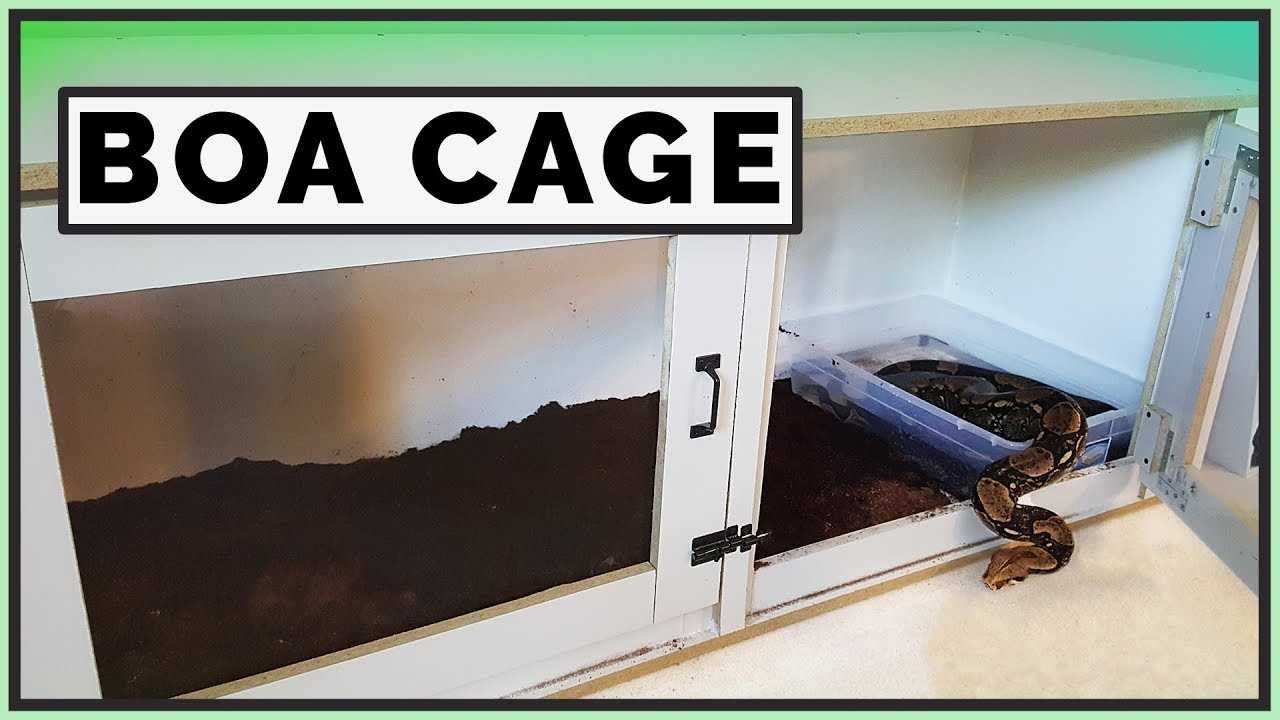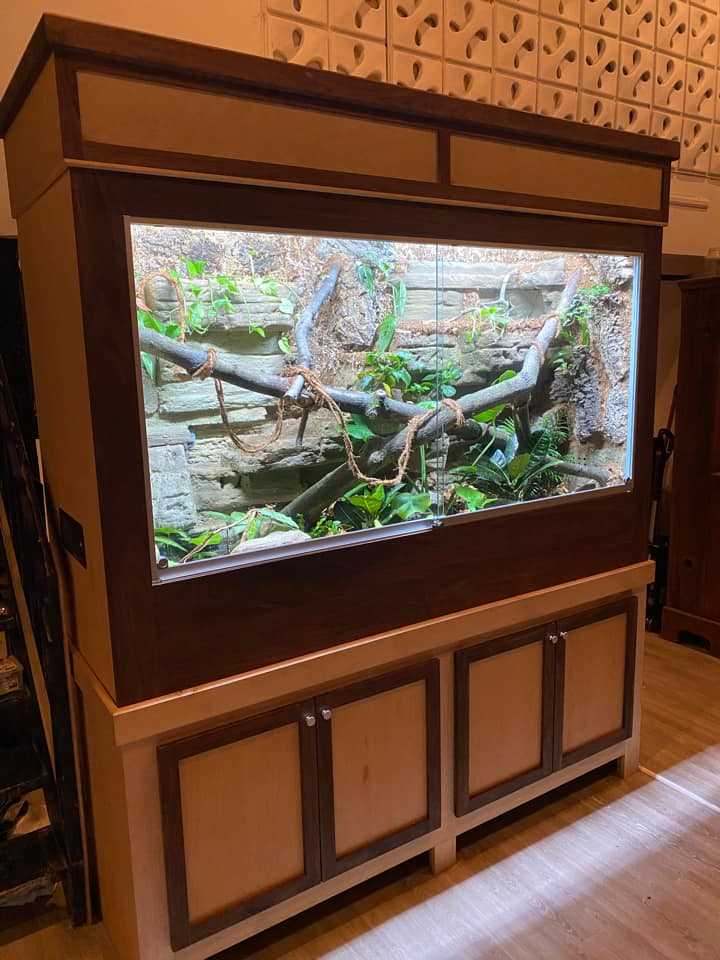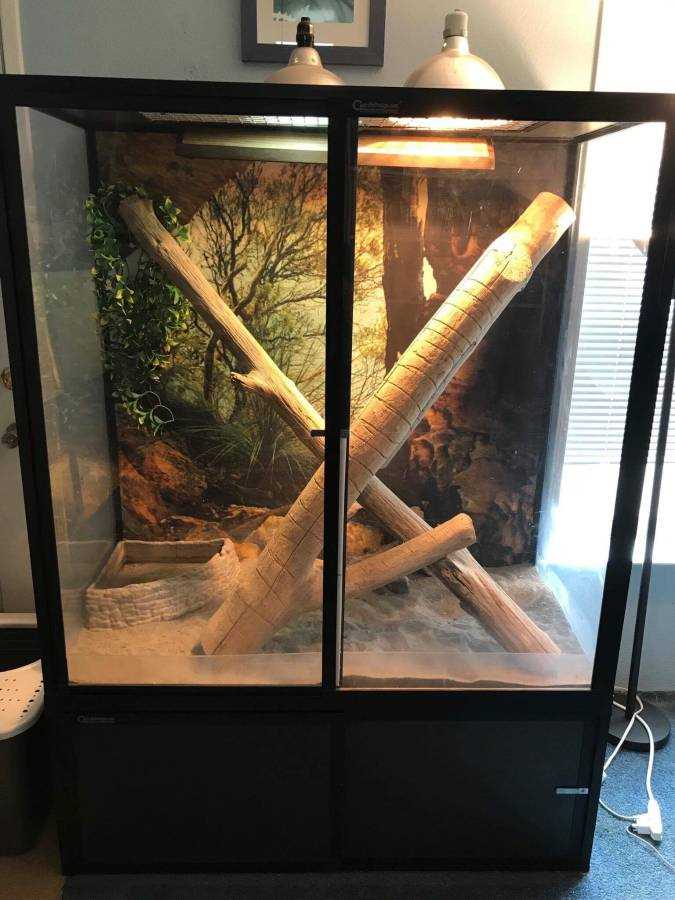Another option is a cage, which is typically constructed with a combination of wire, glass, or plastic. Cages offer good ventilation and are often designed with adjustable components to cater to your snake’s changing needs. With their sturdy construction, cages provide a secure and well-ventilated environment for your boa snake.
If you prefer a more naturalistic setup, a vivarium might be the perfect choice for your boa. Vivariums are designed to mimic the natural habitat of your reptile, with features such as live plants, natural decor, and substrates. These enclosures offer a visually appealing environment for your boa, while also providing enrichment opportunities and promoting their natural behaviors.
Ultimately, the best enclosure for your boa snake will depend on a variety of factors, including the size of your snake, their specific needs, and your personal preferences. Regardless of the option you choose, it’s crucial to ensure that the enclosure provides adequate space, temperature gradients, and hiding spots to create a comfortable and stress-free home for your beloved snake.
Choosing the Right Enclosure

There are several options to consider when selecting an enclosure for your boa snake:
- Cages: There are various types of cages available, including glass cages, PVC cages, and wooden cages. These cages provide a sturdy and secure enclosure for your snake.
- Tanks: Tanks, typically made of glass or acrylic, are another option for housing your boa snake. They offer good visibility and are easy to clean.
- Vivariums: Vivariums are specifically designed enclosures that mimic the natural habitat of your boa snake. They often feature plants, rocks, and other natural elements to create a more realistic environment.
- Terrariums: Similar to vivariums, terrariums are also designed to replicate a natural habitat for your snake. They provide a visually appealing enclosure and are available in various sizes and designs.
In order to choose the right enclosure for your boa snake, there are several factors to consider:
- Size: Boa snakes require a spacious enclosure to allow for movement and exercise. Consider the adult size of your snake and ensure that the enclosure is large enough to accommodate its growth.
- Security: The enclosure should be escape-proof to prevent your boa snake from getting out. Ensure that the materials and construction of the enclosure are secure and sturdy.
- Temperature and Humidity: Boa snakes require specific temperature and humidity levels to maintain their health. Choose an enclosure that allows for proper heating and humidity control.
1. Size Requirements
First and foremost, you need to consider the size requirements of your boa snake. Different species and individuals have varying size preferences. A good rule of thumb is to provide an enclosure that allows your snake to fully stretch out and move around comfortably. This will ensure that they have enough space to exercise and explore their environment.
2. Types of Enclosures
There are various types of enclosures available for boa snakes, each with its own advantages and disadvantages. The most common options include:
- Glass terrariums: These enclosures are popular due to their visibility and aesthetic appeal. However, they may not retain heat and humidity as well as other options, so additional measures may be required.
- Wooden enclosures: Wooden enclosures are often custom-made and can provide a natural and attractive habitat for your snake. However, they may require more maintenance and monitoring to ensure proper temperature and humidity.
- Aquariums: While aquariums can be used as boa snake enclosures, they may not provide adequate ventilation. Additionally, the lack of insulation could make it difficult to maintain the right temperature and humidity levels.
- Custom-built enclosures: For owners with specific requirements or preferences, custom-built enclosures may be the best option. These can be tailored to suit your snake’s needs, ensuring they have the perfect environment.
3. Temperature and Humidity Control
Consider implementing a heating system, such as heat mats or ceramic heat emitters, to provide the necessary warmth. It is also recommended to have a hygrometer and a misting system to monitor and regulate the humidity levels within the enclosure.
4. Security and Accessibility

Ensure that the chosen enclosure provides proper security for your boa snake. It should have secure locks or latches to prevent any accidental escapes. Additionally, the enclosure should allow for easy access for cleaning and maintenance purposes, with removable panels or doors.
Remember, the comfort and safety of your boa snake should always be the top priority when selecting their enclosure. By considering these factors and doing thorough research, you can provide your snake with a suitable and enjoyable habitat to thrive in.
Additionally, boas need enough space to create thermal gradients within their enclosure. This means that you should provide a temperature gradient from one end of the enclosure to the other, allowing the snake to regulate its body temperature by moving between warmer and cooler areas. A larger enclosure will make it easier to create and maintain the desired temperature gradient.
Ultimately, the size of the enclosure plays a crucial role in the overall well-being of your boa snake. By providing a spacious and appropriately sized enclosure, you are ensuring that your snake has enough room to move, explore, and create a comfortable environment that mimics its natural habitat. This will help promote the snake’s physical and psychological health, leading to a happy and thriving pet.
Types of Enclosures
| Enclosure Type | Description |
|---|---|
| Vivarium | |
| Cage | A cage is a simple and cost-effective option for housing a boa snake. It can be made of various materials like plastic or metal, and usually has a removable top for easy access to the snake. |
| Shelter | A shelter is a small enclosed space that provides a sense of security for the snake. It can be as simple as a hide box or as elaborate as an underground burrow. |
| Terrarium | A terrarium is a glass enclosure that allows for optimal visibility of the snake. It usually has a secure lid and can be customized with various decorations like plants and branches. |
| Habitat | A habitat is a larger and more complex enclosure that attempts to recreate the natural environment of the snake. It often includes features like live plants, climbing structures, and water features. |
| Tank | A tank is a generic term for any type of enclosed container used to house a snake. It can be made of glass, plastic, or acrylic and can be as basic or as elaborate as desired. |
| Custom Built Enclosure | A custom built enclosure is a unique and tailored housing option for a boa snake. It can be constructed to meet specific size and design requirements and can include features like built-in heating and lighting. |
Before selecting an enclosure for your boa snake, be sure to research the specific needs of your snake species and consult with experienced reptile keepers or herpetologists. With the right enclosure, your boa snake will have a safe and comfortable home for years to come.
Glass Terrariums for Boa Snakes: The Perfect Shelter
The Benefits of Glass Terrariums

Glass terrariums are commonly used for housing reptiles because they offer several advantages. First and foremost, they provide optimal visibility, allowing you to observe your boa snake from all angles. This is not only enjoyable for you as an owner, but it also helps create a stimulating environment for your snake.
Another benefit of glass terrariums is their ability to retain heat and humidity. Boa snakes require specific temperature and humidity levels to thrive, and glass enclosures excel at maintaining these conditions. This is especially important if you live in a colder or drier climate, as it can be challenging to maintain the proper environment in other types of enclosures.
Choosing the Right Glass Terrarium
Terrarium Setup
Now that you’ve chosen your glass terrarium, it’s time to set it up as a comfortable and stimulating habitat for your boa snake. Start by adding a suitable substrate, such as reptile bark or coconut husk, to the bottom of the enclosure. This will provide a naturalistic and comfortable surface for your snake to rest on.
Don’t forget to include a water dish large enough for your snake to soak in and drink from. Proper hydration is essential for boa snakes, so ensure the water dish is always clean and filled with fresh water.
Maintaining a Glass Terrarium
Regular maintenance is crucial to keep your boa snake’s glass terrarium clean and healthy. Perform regular spot cleanings to remove any waste and debris, and thoroughly clean the enclosure every few months. Use a reptile-safe disinfectant to sanitize the interior of the terrarium.
Finally, be sure to monitor the temperature and humidity levels inside the terrarium closely. Invest in a reliable thermometer and hygrometer to ensure the conditions remain optimal for your boa snake’s health and well-being.
Choosing the Right PVC Cage for Your Boa Snake
One of the main advantages of PVC cages is their insulation properties. Unlike glass terrariums, which often struggle to maintain a consistent temperature, PVC cages provide excellent heat retention. This helps create a warm and cozy environment for your boa snake, replicating its natural habitat.
PVC cages also offer great visibility. They usually come with large front-opening doors, allowing you to easily observe and interact with your boa snake. This is especially important if you enjoy watching and studying your pet.
When choosing a PVC cage for your boa snake, make sure to consider its size requirements. Boa snakes come in various sizes, so you need to select an enclosure that provides ample space for your pet to move, explore, and stretch out.
Lastly, PVC cages are a popular choice among reptile enthusiasts because they are customizable. Many manufacturers offer various options for ventilation, lighting, and heating, allowing you to tailor the cage to your specific needs and preferences.
Wooden Enclosures: A Natural and Secure Home for Your Boa Snake
Wooden enclosures also provide a sense of security for your boa snake. The solid, sturdy walls of the cage create a safe and protected environment, reducing stress and promoting a healthy living space. Additionally, the natural appearance of wood can help create a more aesthetically pleasing habitat for both you and your snake.
Another important factor to consider when selecting a wooden enclosure is the type of wood. It is essential to use untreated wood to avoid any potential harm to your snake. Pine and cedar should be avoided due to their aromatic oils, which can be toxic to reptiles. Instead, opt for hardwoods such as oak or birch, which are safe and durable options.
Proper ventilation is also essential in wooden enclosures to prevent the buildup of stagnant air and to maintain optimal air quality for your snake. Ensure that the enclosure has adequate ventilation holes or mesh panels to allow for proper airflow.
Aquariums as Boa Snakes Enclosures

Advantages of Using Aquariums
1. Size: Aquariums can be found in various sizes, allowing you to choose the one that suits your snake’s needs. Boas require a spacious enclosure to move around and explore, and aquariums provide enough room for them to do so.
2. Visibility: Glass tanks offer excellent visibility, allowing you to observe your snake and enjoy their natural behaviors. It also provides a visually appealing display for your home or office.
3. Security: Aquariums provide a secure and escape-proof environment for boa snakes. The glass walls prevent the snake from climbing out or other pets from disturbing them.
Considerations When Using Aquariums
2. Heating and Lighting: Boa snakes need a temperature gradient in their enclosure. Ensure that the aquarium has space for heating elements, such as heat mats or ceramic heat emitters, to provide the required warmth for your snake.
4. Environmental enrichment: Provide hiding spots, branches, and other furnishings to create a stimulating and enriching environment for your boa snake. This allows them to exhibit natural behaviors and feel secure.
5. Cleaning and Maintenance: Regular cleaning and maintenance are essential to keep the aquarium hygienic and prevent the build-up of bacteria. Remove waste, clean the enclosure, and change the substrate regularly.
6. Size limitations: While aquariums offer various sizes, they may not be suitable for adult boa snakes or larger species. Consider the eventual size of your snake and ensure that the aquarium provides enough space for their growth.
Custom Built Enclosures
A custom built enclosure for a boa snake is a great option for providing a unique and customized habitat for your pet. These enclosures are often made by reptile enthusiasts who have experience in constructing vivariums and can offer a variety of features to meet the specific needs of your boa.
When choosing a custom built enclosure, there are several factors to consider. First, you’ll need to determine the size requirements for your boa snake based on its current size and potential growth. The enclosure should be large enough to allow the snake to move freely and provide plenty of hiding spots and climbing opportunities.
Custom built enclosures can be made from various materials, including wood, acrylic, or PVC. Wood is a popular choice for its natural appearance and ability to retain heat, but it may require more maintenance to control humidity levels. Acrylic enclosures offer a clear view of your snake and are easy to clean, but they may not retain heat as well. PVC enclosures are durable, lightweight, and easy to maintain, making them a popular choice among reptile keepers.
One advantage of a custom built enclosure is the ability to add specific features and accessories. You can include branches, rocks, and plants to create a natural and stimulating environment for your boa snake. You can also customize the lighting and heating options to ensure optimal temperatures and UVB exposure.
| Pros | Cons |
|---|---|
| – Customized to meet specific needs | – Potentially more expensive |
| – Ability to add features and accessories | – May require more maintenance |
| – Wide range of material options | – Time-consuming construction process |
| – Expertise of a reputable builder | – Requires careful research and selection |

I’m Lena Adams—a product of an unconventional upbringing in the African wilderness. My father, a daring explorer of African wildlife, sparked my fascination with reptiles, a passion that intertwined with the tragic loss of my mother during an expedition, leaving an indelible mark on my life. Driven to understand the creatures that captivated my parents, I embarked on my journey, sharing insights about reptiles, frogs, and lizards on my website. Through my explorations and conservation efforts, I honour my family’s legacy while seeking connections—to the creatures, nature, and the mother whose presence I yearn to understand.
